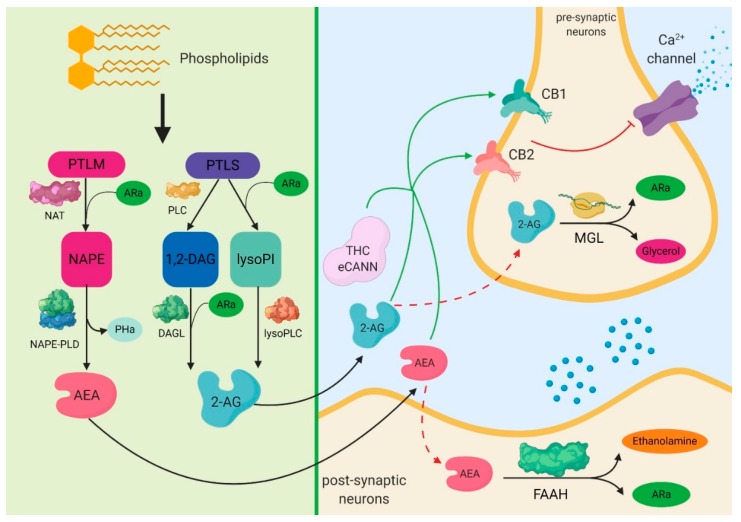Figure 1.
Molecular signaling mediated by the endocannabinoid system in the central nervous system. The most important endocannabinoid systems are the anandamide and the 2-arachidonoylglycerol, which also have high concentrations in the brain. Anandamide can be obtained through a series of biological mechanisms that involve the restructuring of phospholipids by the N-acyl-transferases. 2-arachidonoylglycerol results from the action of phospholipase C-beta enzymes or after the dephosphorylation of lysophosphatidic acid. Following these reactions, both anandamide and 2-arachidonoylglycerol activate the G-protein coupled receptors, transient receptor potential vanilloid type 1, and peroxisome proliferator-activated nuclear receptors. Finally, cyclooxygenase-2 can act on these two endocannabinoids through redox mechanisms, leading to the production of prostamides and prostaglandin-glycerol esters. PTLM: lipid precursor phosphatidylethanolamine; NAT: N-acyltransferase; ARa: arachidonic acid; NAPE: N-arachidonoyl-phosphatidylethonolamine; NAPE-PLD: NAPE-phospholipase D; PHa: phosphatidic acid; AEA: anandamide; PTLS: lipid precursor phosphatidylinositol; PLC: phospholipase C; 1,2-DAG: 1,2-diacylglycerol; lysoPI: 2-arachidonoyl-lysophospholipid; DAGL: diacylglycerol lipase; lysoPLC: lysophosphilipase C; 2-AG: 2-arachidonoylglycerol; CB1: cannabinoid receptor 1; CB2: cannabinoid receptor 2; THC: tetrahydrocannabinol; eCANN: endogenous and exogenous cannabinoids; MGL: monoacylglycerol lipase; FAAH: fatty-acid amide hydrolase.

